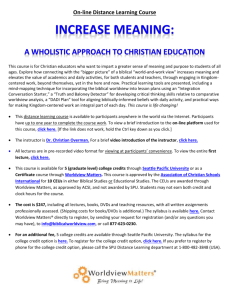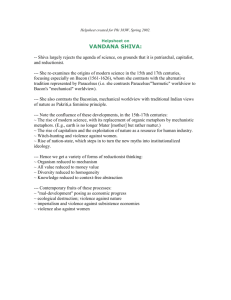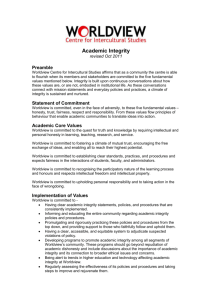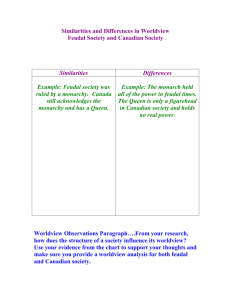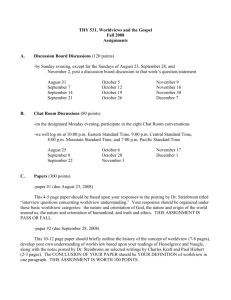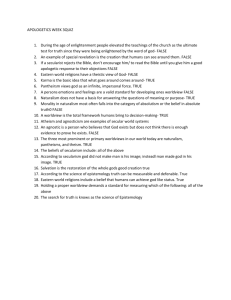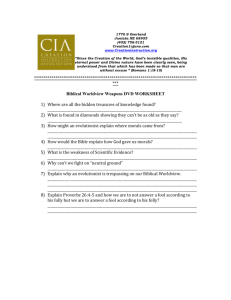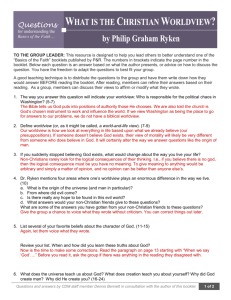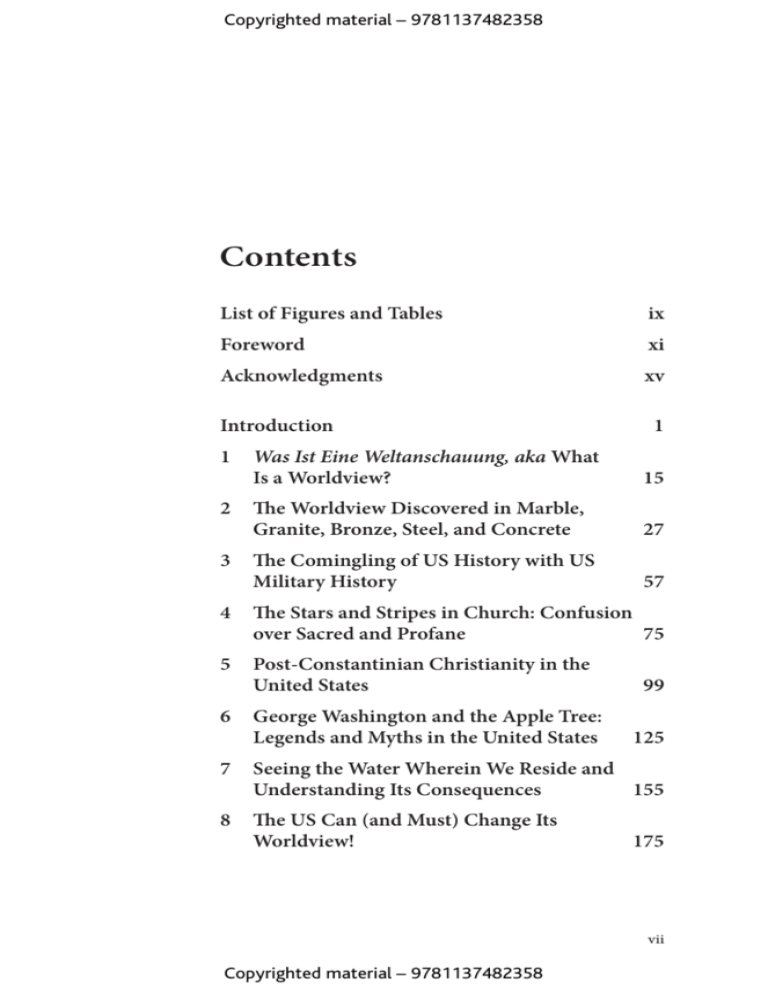
Copyrighted material – 9781137482358
Contents
List of Figures and Tables
ix
Foreword
xi
Acknowledgments
xv
Introduction
1
2
3
1
Was Ist Eine Weltanschauung, aka What
Is a Worldview?
15
The Worldview Discovered in Marble,
Granite, Bronze, Steel, and Concrete
27
The Comingling of US History with US
Military History
57
4
The Stars and Stripes in Church: Confusion
over Sacred and Profane
75
5
Post-Constantinian Christianity in the
United States
99
George Washington and the Apple Tree:
Legends and Myths in the United States
125
6
7
Seeing the Water Wherein We Reside and
Understanding Its Consequences
155
8
The US Can (and Must) Change Its
Worldview!
175
vii
Copyrighted material – 9781137482358
Copyrighted material – 9781137482358
viii
Contents
References
195
Index
205
Copyrighted material – 9781137482358
Copyrighted material – 9781137482358
THE WORLDVIEW OF REDEMPTIVE VIOLENCE IN THE US
Copyright © Wayne Lavender, 2015.
All rights reserved.
First published in 2015 by
PALGRAVE MACMILLAN®
in the United States—a division of St. Martin’s Press LLC,
175 Fifth Avenue, New York, NY 10010.
Where this book is distributed in the UK, Europe and the rest of the world,
this is by Palgrave Macmillan, a division of Macmillan Publishers Limited,
registered in England, company number 785998, of Houndmills,
Basingstoke, Hampshire RG21 6XS.
Palgrave Macmillan is the global academic imprint of the above companies
and has companies and representatives throughout the world.
Palgrave® and Macmillan® are registered trademarks in the United States,
the United Kingdom, Europe and other countries.
ISBN: 978–1–137–48235–8
Library of Congress Cataloging-in-Publication Data is available from the
Library of Congress.
A catalogue record of the book is available from the British Library.
Design by Newgen Knowledge Works (P) Ltd., Chennai, India.
First edition: January 2015
10 9 8 7 6 5 4 3 2 1
Copyrighted material – 9781137482358
Copyrighted material – 9781137482358
Introduction
One thing about which fish know exactly nothing is water, since they have no anti-environment which would
enable them to perceive the element they live in.
—Marshall McLuhan
While traveling on a domestic flight in 2008 I
had an unforgettable experience. I was seated
next to a pleasant woman who was on a business trip. We shared some casual conversation
before she asked me this simple question:
“What do you do for a living?” I could have
replied with several answers. I am, and have
been since 1986, a United Methodist pastor. The
story is, however, a bit more complicated. In
2005, I became the director of a small nonprofit
organization called “Passing the Peace.” I wrote
my first book, Counting Ants While the Elephants
March By. At the time I was also a PhD student
at George Mason University’s School of Public
Policy. I could therefore have answered that
I am a pastor, a director, author, or student.
Instead, I tried this: “I am a peacemaker.” She
acknowledged my answer and was quiet for a
moment before replying: “You don’t seem to be
doing a very good job of being a peacemaker.”
1
Copyrighted material – 9781137482358
Copyrighted material – 9781137482358
2
The Worldview of Redemptive Violence in the US
She was joking, of course, and we both laughed before
settling into the flight and our reading material. After the
trip we wished each other well and said goodbye. I imagine
she has no memory of this event, but it has stayed with me
and is something I think about almost every day. What kind
of a peacemaker am I? Am I doing “a very good job of it?”
Maybe not.
When we total the human and financial resources the
United States marshals for war and warmaking activities
and compare them with the resources this nation mobilizes
for peace and peacemaking activities we quickly see an
enormous disparity, an inequality of epic proportions. The
United States spends a great amount of its resources on war
and warmaking activities (a total of $1.2 trillion per year
when all of the different military-related expenditures are
added together) but, in comparison, precious little on peace
and peacemaking programs (a total of $50 billion through
USAID, State Department, Peace Corps). Is it possible to
be a peacemaker within a nation wherein this imbalance
between war and peace spending is so extreme? Is it possible to be a peacemaker in a nation that is, in effect, today’s
global empire?
The existence of a dominant worldview within the United
States that supports the myth of redemptive violence indicates that it will be difficult, at best, for the United States
to take a leading role in creating and promoting a world of
peace in justice. An illustration of this worldview can be
seen in the book Charlie Wilson’s War (and subsequent movie
starring Tom Hanks, Julia Roberts, and Philip Seymour
Hoffman). The book traces the personal and professional
story of Congressman Charlie Wilson (Texas, R), who was
responsible for getting his colleagues in the US Congress to
deliver billions of US federal dollars to insurgents and guerrilla fighters in Afghanistan to support their war against the
Copyrighted material – 9781137482358
Copyrighted material – 9781137482358
Introduction
3
Soviet Union. The funds were sent under the broad-brush
realpolitik strategy that the “enemy of my enemy is my
friend.” The program worked: supported, in part, by funding
from the United States, the Afghani guerilla fighters were
able to force the Soviets to withdraw from their nation.
But as the war came to an end with the withdrawal of the
Soviet troops, Wilson tried to secure US financial support
for peace-building activities in the postconflict nation. The
humanitarian projects included the construction and staffing of schools, hospitals, and governmental services including roads and other infrastructure. These peacemaking
activities cost millions of dollars compared to the billions of
dollars Representative Wilson was able to secure for weapons. His attempts at securing funding for peaceful activities
failed. Frustrated, Wilson himself summarizes his experience: “These things happened. They were glorious and they
changed the world. And the people who deserve the credit
are the ones who made the sacrifice. And then we fucked up
the endgame” (Crile 2003:520).
The dominant worldview within the United States, then,
made it easy for a rather obscure member of Congress to funnel billions of dollars to fund a military operation in Central
Asia but did not allow the same person to fund millions of
dollars of life-sustaining, humanitarian aid to these people.
It was relatively easy for Charlie Wilson to be a warmaker,
but not so much for him to be a peacemaker.
Living in a Fishbowl
It is said that a fish does not see the water in which it swims.
This means that fish—were they intelligent enough for
consciousness—would be unable to perceive or understand
that they live in water because this is the only environment
Copyrighted material – 9781137482358
Copyrighted material – 9781137482358
4
The Worldview of Redemptive Violence in the US
that they have experienced. They know nothing of the air
above them or the land that rises out of the sea because
these settings are totally foreign to fish. Fish are products of
their environment—water—and incapable of perceiving this
very water because it’s the only reality they have ever experienced. As Marshall McLuhan puts it: “One thing about
which fish know exactly nothing is water, since they have no
anti-environment which would enable them to perceive the
element they live in” (McLuhan 1968:175).
In the same manner, human beings are products of their
environments. Most people live within one culture, one
nation, one environment, and therefore take that setting as
normative, ordinary, and routine. They do not see the specific, unique elements from which their culture is comprised
and are often oblivious to the subtle and not-so-subtle cultural influences that shape them. S. Martin Lipset frequently
said: “Those who only know one country know no country.”
Lipset suggested that a person who lives his or her whole
life within one nation, one culture, can not objectively see
the culture (water) in which they reside (swim), because it is
only in comparison to other cultures that individuals learn
of their own.
Citizens of the United States, like citizens of other nations,
consider their culture to be “normal,” “conventional,” “usual,”
or “typical.” But because the great majority of Americans do
not travel overseas, the majority of Americans do not have
the opportunity to experience other cultures. According
to the US State Department, 109 million Americans own
passports, a number that equates to about 35 percent of the
population. Of this figure, though, it has been estimated
that 14.6 million Americans travel overseas each year—less
than five percent of all Americans (Chalmers 2012). Because
most US citizens do not travel overseas, most of them do not
have an opportunity to experience a foreign culture. What
Copyrighted material – 9781137482358
Copyrighted material – 9781137482358
Introduction
5
follows, then, is that most of them do not have the ability to
see their own culture objectively, with the critical perspective
of an outside, different viewpoint. US citizens—like citizens
of other nations who do not travel beyond their borders—
accept qualities or characteristics within the US culture as
normal, the same qualities and characteristics that might
seem abnormal or strange to someone from another nation.
Persons, who travel and live abroad, return home with
a richer understanding of the nation(s) they have been to
and of their own nation. This is one of the benefits of foreign exchange programs, studying abroad, participating in
the Peace Corps or other programs in which citizens are
immersed in a foreign nation and able to observe and participate in its culture. These persons return to their homes
having gained not only knowledge of the other culture,
where they have visited, but also a new perspective and
understanding of their own culture. They can more clearly
and objectively see the “water” in which they live.
I write this book to help citizens of the United States see
the water in which they swim in regard to military spending and warmaking activities vis-à-vis spending on peace
and peacemaking activities. I have been fortunate to have
traveled to over 20 foreign countries, and have spent at least
two months living in four of these countries. These experiences have helped shape who I am and the more objective
perspective I have of the United States: they help me to see
and understand the US culture from “an outsider” vantage
point, something I would not have gained without these
opportunities to travel and live overseas.
My experience and observations led me to undertake a
more formal examination of my native land, culture, and
worldview. Research that I conducted during the past three
years but, in general, have been observing my entire lifetime,
demonstrates the existence of a dominant worldview within
Copyrighted material – 9781137482358
Copyrighted material – 9781137482358
6
The Worldview of Redemptive Violence in the US
the United States that accepts and believes in the Myth of
Redemptive Violence. The Myth of Redemptive Violence is,
as defined by the originator of the phrase, Walter Wink, the
belief that violence—for example, military force, death, and
destruction—is justifiable in order to improve the human
condition and create societies of peace and order. It is, as
the name implies, the application of “violence” in order to
“redeem”: it is the waging of war for the purpose of achieving justice and peace. The Myth of Redemptive Violence is,
in the words of Walter Wink, “the simplest, laziest, most
exciting, uncomplicated, irrational, and primitive depiction
of evil the world has ever known” (Wink 1998:52).
Most US citizens know nothing of this myth and are
unaware of how it helps shape US policies. But the Myth of
Redemptive Violence worldview does exist and can be discerned through an analysis of the building blocks of worldview, namely (1) collective memory, (2) history, (3) symbols,
(4) religion, and (5) legends and myths.
This dominant worldview, like the water in which fish
swim or the air that we breathe, permeates the mindset of
US citizens and the US society but is often invisible to the
very people who support and perpetuate its existence. It can
be observed, however, through the plethora of war-related
monuments and memorials in 70 percent of the towns and
cities of the United States, and in the corresponding lack of
peace-related monuments and memorials in the same towns
and cities: it is manifested in the national holidays that
celebrate important war-related moments in history and
in the virtual absence of national holidays that commemorate peace-related highpoints in US history. Likewise, this
redemptive violence worldview is taught in the US history
textbooks that focus on the wars the United States has been
involved in and in the details of the lives and activities of
warmakers, while these same textbooks pay little attention to
Copyrighted material – 9781137482358
Copyrighted material – 9781137482358
Introduction
7
exploring US eras of peace and prosperity, while simultaneously dismissing the lives and contributions of peacemakers.
It is embedded in the US worldview through the manner in
which the military is portrayed in numerous cultural events,
ranging from sporting events, concerts, movies, and television. This worldview can be discovered at the National Parks
established to preserve key military battles, and in the words
and actions of politicians and national leaders whose words
convey a deep belief in the theme of redemptive violence.
Finally, this worldview is observed in the specific manner
in which Christianity is understood and practiced in the
United States, most often as an evangelical and aggressive
faith engaged in world conversion and transformation.
One of the most obvious outcomes of this dominant
worldview is an out-of-balance preference for military
spending and military solutions to international concerns
and conflict. While there are always alternatives to military
intervention to resolve international problems and conflict,
all too often the United States plays the military card. This
default position—which is akin to an instinctive predisposition toward the military—is deeply ingrained in the US
worldview and is expressed in and through the US spending
priorities and through military interventions around the
planet.
Athens versus Sparta
At some point in high school, most US students are introduced to the history of Ancient Greece. In an overly simplified manner Athens is portrayed as a model society, with
democracy, freedom, and culture. This idealized community
is foiled with Sparta, which is presented as a militaristic
society led by an oligarchy and dominated by its passion for
Copyrighted material – 9781137482358
Copyrighted material – 9781137482358
8
The Worldview of Redemptive Violence in the US
discipline, power, and order. The two cities fought in what is
known as the Peloponnesian War, in which Sparta eventually prevailed.
Most citizens of the United States identify with Athens—
the ideal democratic community with its emphasis on philosophy, democracy, freedom, literature, the arts and culture.
They see the United States within this framework and whose
mission is to spread these ideals to the rest of the world.
But like the fish that does not see the water in which
it swims, many US citizens do not think about the reality that ancient Athens was based on slavery, and that it
too was an extremely militaristic society. Likewise, most
Americans do not see the similarities their country shares
with ancient Sparta––namely, that we, like Sparta, are a
nation rooted in militarism. The United States rose to its
position as today’s global power the old fashioned way:
like previous empires, the United States achieved population and economic growth that fueled military expansion
and conquest. Today, the United States dominates the
world via its economic and cultural influence, backed by
military strength. Currently, the United States has over
800 military bases in 130 foreign nations, which means
that the United States has stationed military personnel
from the Army, Navy, Marines, and Air Force in approximately two-thirds of the nations of the planet. Make no
mistake, as Adrian Lewis reminds us, “The United States
became a ‘superpower’ through war, and has retained that
status because of war” (Lewis 2007:7).
A militaristic society, based on a redemptive violence
worldview, is problematic, however, for three reasons.
1. It is unsustainable. Current military spending (counting
all related items) in the United States exceeded $1 trillion in
2007 and currently stands at approximately $1.2 trillion. The
US Federal Government does not have a spending problem,
Copyrighted material – 9781137482358
Copyrighted material – 9781137482358
Introduction
9
per se, but a military spending problem. Continued military
spending at current levels will continue to place stress on
federal spending and divert scarce resources that otherwise
could be used to improve humanitarian conditions (health
and education) both within the US and overseas.
2. It is immoral. War and the making of war are evil activities
leading to the direct and intentional killing of adversaries
and the corresponding collateral deaths of innocent
civilians. While many “justify” war as a “necessary evil”
that nevertheless still defines war and warmaking as evil.
3. It is ineffective. While national security continues to
be a real concern, the making of war and ongoing death
and destruction it causes will be counterproductive,
given the complex and nuanced problems confronting
the human family at the beginning of the twenty-first
century. US military strength will not solve the daunting
challenges of global climate change, extreme poverty, or an
overabundance of weapons found around the world: the
truth is US military actions will make these issues worse
and contribute to a vicious and escalating cycle of violence
into the future.
A new paradigm, a new worldview must be developed
in which a genuine and significant Pax Americana can be
achieved. This alternative worldview will more closely
resemble these words of President Franklin D. Roosevelt,
who in his fourth inaugural address said: “We have learned
that we cannot live alone, at peace; that our own well-being
is dependent upon the well-being of other nations, far
away. . . . We have learned the simple truth, as Emerson said,
that ‘the only way to have a friend is to be one.’”
There is some good news. My research also discovered a
recessive worldview within the United States that offers a
different perspective: this recessive worldview favors peaceful, nonviolent forms of cooperation and conflict resolution.
This worldview currently exists within the United States as
Copyrighted material – 9781137482358
Copyrighted material – 9781137482358
10
The Worldview of Redemptive Violence in the US
a recessive, latent perspective: policy recommendations will
be offered in which this recessive worldview can be nurtured
and developed that would offer the world’s people better
options for peace with justice.
The Fishbowl Metaphor
A fishbowl or aquarium is the metaphor I have chosen to
frame this book so that readers can see and understand the
dominant worldview at work within the United States in
regard to redemptive violence. Fish, living in a large body of
water or a fishbowl, are unable to see the water in which they
live out their lives. Their “environment” varies depending on
whether we are considering fresh or saltwater fish, or fish
that live in rivers as opposed to fish that dwell in the open
sea, but all fish live in particular settings and have a certain
background in which they swim. Most aquariums seek to
replicate a particular setting or background, the natural
environment in which fish live, and therefore often have
an oxygen bubbler, a water filter, plant life and greenery, a
thermometer/water heater, and, of course, fish food. These
components of a fishbowl or aquarium, along with the water
and exterior glass itself, provide the environment in which
the fish we keep as pets live.
Likewise, human beings reside in a particular culture with
its corresponding worldview, but they often cannot see their
own culture and worldview precisely because they have only
been exposed to their specific culture and worldview. All
human beings live in specific environments that vary from
mountains to plains, from deserts to rain forests. Aside from
the physical variants, all humans live in societies surrounded
by specific collective memories, history, symbols, religion,
and legends and myths. These components are the building
Copyrighted material – 9781137482358
Copyrighted material – 9781137482358
Introduction
11
blocks of worldview and structures around which this book
is constructed.
The first chapter of this book explores the concept of
worldview, from its genesis and definition to how worldviews
reflect and reinforce the culture in which they are nested
in an ongoing feedback loop. This chapter will define and
explain further the metaphor of the fishbowl. Chapters 2 to 6
will figuratively pair the different components of a fishbowl
with the different components of worldview. I admit that
the linking of items found within a fishbowl to the building
blocks of worldview is somewhat random and arbitrary, but
the associations have been made deliberately and after considerable thought in an attempt to help convey the presence
of these worldview-making components for those willing to
see the US worldview more clearly and objectively.
Collective memory, one of the building blocks of worldview, is discussed in chapter 2 under the image of an oxygen
bubbler. An oxygen bubbler is the devise in which air is
pumped into the water to increase the level of oxygen so that
the fish can breathe. I associate the oxygen bubbler in the
fishbowl with collective memory, the shared pool of memories held in common by two or more members of any group.
The oxygen bubbler helps provide an ingredient (oxygen)
that the fish need in order to survive: similarly, collective
memory helps provide a setting and context in which humans
find identity. One of the ways in which collective memory is
documented and passed on to future generations is through
the construction of public monuments and memorials. In
this chapter we will examine the war and peace monuments
and memorials located in towns and cities from five selected
states across the United States and within the nation’s capital,
Washington DC itself.
History is another building block of worldview and, like
collective memory, is also studied in order to learn about
Copyrighted material – 9781137482358
Copyrighted material – 9781137482358
12
The Worldview of Redemptive Violence in the US
what took place in the past, be it ancient or modern history. The value of history is that we can learn from the past
and the persons who helped create our current conditions
in order to inform our present and shape the future: I use
the image of the water filter for chapter 3 and my discussion
of history because a water filter in an aquarium is used to
screen out dirt and other impurities and clean the water. In a
similar manner, history “screens out” items and sorts what is
important in our past from what is not.
Chapter 4 focuses on symbols, the third building block of
worldview. Symbols are present in all cultures and are words,
sounds, gestures, or visual images used to express concepts,
ideas, or beliefs. As such, symbols are somewhat like the
background of a society. I therefore associate symbols in my
figurative fishbowl with the plant life and greenery placed in
the tank as background for the fish and human observers.
Religion is the fourth building block of worldview and
discussed in chapter 5. Religion will be paired in this book
with the thermometer/water heater found in fishbowls.
Thermometers are used to measure the temperature—an
aquarium’s thermometer records and displays the temperature of the water inside an aquarium. When the temperature
drops, a water heater is sometimes used to maintain the
water’s warmth and comfort range of the fish. Martin Luther
King Jr. compared religion to a thermostat, saying that
religion can turn the temperature up or down in a society
depending on the words of its leaders and interpretations
of its sacred texts. The dominant religion within the United
States is Christianity, and in the United States Christianity
presents itself primarily as a proselytizing, evangelical,
conversion religion. Further, Christianity—since the time
of Constantine—has been associated with state and military
power: National leaders—kings, emperors, and elected
officials—have used religion for centuries to justify war and
Copyrighted material – 9781137482358
Copyrighted material – 9781137482358
Introduction
13
as the means in which to explain and validate decisions to
wage war.
Legends and myths are the fifth building blocks of worldview and are discussed in chapter 6. Some legends and myths
feed our sense of national identity and serve to enhance our
patriotism and national pride. They sustain nationalism
and feed patriotism as fish food nourishes our fish friends.
I therefore use the image of fish food as the image from the
fishbowl in which to represent legends and myths.
Chapters 2–6, using the metaphor of the fishbowl and pairing its components with the building blocks of worldview,
illustrate how and why the United States accepts the myth of
redemptive violence as its dominant worldview. Chapter 7,
then, describes the consequences of this worldview for both
the United States and world. I maintain that this worldview
is unsustainable, immoral, and counterproductive to the
great needs of the twenty-first century.
Chapter 8, the final chapter of the book, offers suggestions
in which the dominant worldview may be replaced with
what today can be found within the United States as the
recessive worldview. These suggestions are offered with the
hope of saving the United States from its current trajectory.
Further, the suggestions in chapter 8 are offered because I
still believe it is possible for the United States to lead and
usher in a golden era of peace and prosperity for the world’s
people, but this can only be accomplished if enough people
can see and understand the destructive power of the myth of
redemptive violence.
Seeing and understanding the worldview that surrounds
us in regard to the existence of a worldview that accepts the
myth of redemptive violence is the essential first step in determining how to change direction as a nation. This knowledge
will, I hope, enable reasonable policy decisions to be made in
order to avoid a dystopian future that otherwise awaits.
Copyrighted material – 9781137482358
Copyrighted material – 9781137482358
Index
Adams, John, 64
Albright, Madeline, 120
Alger, Horatio Jr., 137, 152
Appleseed, Johnny, 135–6
Athens vs. Sparta Metaphor,
7–8
Constantine, 12, 34, 100,
108–11, 122
Couric, Katie, 17
Crusades, 99, 104, 105,
112–14, 122, 145
Custer, George, 61, 185
Bellah, Robert, 92–3, 117, 118
Bellamy, Francis, 84–5
Bennett, William, 66, 71–2
Berlin Wall, 78
Berrigan, Daniel, 68, 69, 70,
71, 103
Beveridge, Albert, 119
Bilmes, Linda, 163
Bonaparte, Napoleon, 34,
86, 165–6
Brown, Dee, 61
Brown, Robert McAfee, 15,
21, 106
Bunyan, Paul, 136
Bush, George W., 103, 120,
167–8
Day, Dorothy, 67, 69, 71, 103
Douglas, Frederick, 65, 181
Dyer, Wayne, 155, 157
Dylan, Bob, 178
Campbell, Joseph, 125, 129
Chapman, John, 135–6
Charlemagne, 112, 165
Christianity, definition,
105–7
Claus, Santa, 130
Clement of Alexandria,
107
Coffin, William Sloan, 123,
167–8
Easterly, William, 191
Eisenhower, Dwight David,
64, 67, 69, 85, 159, 165
Elshtain, Jean Bethke, 99
environmental degradation,
167–9
Eusebius, 110
Falwell, Jerry, 103
Faulkner, William, 30
Fenelon, Francois, 175
fishbowl metaphor, 3–5, 10–13
Ford, Harrison, 148, 149
Fox, George, 103, 132
Francis, St. (of Assisi), 103
Franklin, Benjamin, 30, 64,
93, 132
Freeman, Douglas, 86–7
Gandhi, Mohandas, 50,
100–1, 150, 189
Gates, Robert, 162
205
Copyrighted material – 9781137482358
Copyrighted material – 9781137482358
206
Index
Gettysburg, Pennsylvania, 32–4, 41,
87, 93
Gibbons, Edward, 183
Gorbachev, Mikhail, 20, 45, 78
Grant, Ulysses, 32, 38, 39, 45, 47, 51,
64, 67, 69, 83–4, 86, 165
Halbwahs, Maurice, 28
Hale, Nathan, 46, 60, 67, 69, 152
Hanh, Thich Nhat, 21
Hellman, Chris, 162
Henry, Patrick, 64
Heraclitus, 15–16, 25, 26
Herodotus, 58
Higgs, Robert, 162
Hill, Anita, 180
Hippolytus, 108
Hiroshima, 59
Huckabee, Mike, 101
Huxley, Julian, 99
Jackson, Andrew (president),
47, 135
Jackson, Andrew (Stonewall), 38, 39,
64, 65, 165
Jackson, Jesse, 101
Jefferson, Thomas, 64, 101, 116
Jesus, 29, 79, 80, 81, 86, 93, 97, 102,
103, 105–7, 109, 110, 111, 112,
118, 130, 139, 140, 146, 176, 182
Joshua, Biblical book, 117, 140–5
Kagan, Robert, 104–5
Kant, Emmanuel, 16–17
Key, Francis Scott, 83
Kilcullen, David, 160–1, 162
King, Martin Luther, 12, 45, 49, 51,
52–3, 54, 67, 69, 71, 82, 179, 181
Korean War Memorial, Washington,
DC, 37, 40, 49, 51
Lactantius, 108
Lazarus, Emma, 77
Lee, Jesse, 67, 70
Lee, Robert E., 64, 65, 67, 69, 70,
86, 165
Lewis, Adrian, 8
Limbaugh, Rush, 17
Lincoln, Abraham, 32, 33, 48, 52, 64,
65, 67, 69, 70, 82, 90, 93, 119,
137, 182
Lincoln, Bruce, 138
Lipset, S. Martin, 4, 60, 104, 117
Love, Alfred Henry, 67, 69, 70, 71
Mandela, Nelson, 186
Marion, Francis, 132–3
Martyr, Justin, 103, 108
McLuhan, Marshall, 1, 4
McNamara, Robert, 59
Mises, Ludwig von, 15, 16, 25, 26, 179
Mother Teresa, 183
Myth of Redemptive Violence, 2–9,
139–51, 182–4
Nagasaki, 59
Nouwen, Henri, 103
Origen, 103, 108
Palin, Sarah, 17
pandemic poverty, 167, 169–71
Pascal, Blaise, 100
Pax Americana, 9, 161, 173, 194
Pearl Harbor, 29, 38, 58, 59, 65
Pledge of Allegiance, 84–6
Pope Francis I, 79
Rankin, Jennette, 49, 52, 67, 69, 70, 71
Reagan, Ronald, 20, 44, 76, 78, 160
Roosevelt, Franklin Delano, 9, 64,
82, 167
Ross, Betsy, 82
Rousseau, Jean-Jacques, 92
Sachs, Jeffrey, 171, 191
Saint Martin of Tours, 107
Savage, Kirk, 27, 34
Schopenhauer, Arthur, 99
Shepherd, Matthew, 180
Sherman, William Tecumseh, 31, 47,
52, 167
Copyrighted material – 9781137482358
Copyrighted material – 9781137482358
Index
Simmons, Menno, 103
Smith, Adam, 20, 163–4
Smith, Anthony, 81–2
Solzhenitsyn, Aleksandr, 183–4
Stars and Stripes, 82–4
Statue of Liberty, 75–7
Stewart, Jon, 17
Stiglitz, Joseph, 163
terroir, 19
Tertullian, 103, 107
Thomas, Clarence, 180
Tocqueville, Alexis de, 117, 119
Tokyo, Firebombing, 59
Tolstoy, Leo, 86, 103
Toynbee, Arnold, 183
Trail of Tears, 65
Truman, Harry, 44, 167
Truth, Sojourner, 65
Tubman, Harriet, 65, 181
Tuveson, Ernest, 120
War of 1812, 38, 44, 45, 58, 83, 159
Warren, Rick, 122
Washington, George, 30, 31, 46, 60,
63, 64, 67, 69, 82, 93, 125–8,
132, 152, 165
Wayne, John, 148–50
Weems, Mason Locke, 126–8, 132–3, 176
207
Weinberg, Steven, 183
Whitehead, Alfred North, 111
Willard Hotel, 49, 52
Wilson, Charlie, 2–3
Wilson, Woodrow, 64, 120
Wink, Walter, 6, 139–40, 150
Winkle, Rip Van, 136
Winthrop, John, 91, 116, 119
Wittgenstein, Ludwig, 130
Wojtyła, Karol Józef, 20
World War II Memorial,
Washington, DC, 50–1
worldview
building blocks, 6, 156–7
collective memory, 29–32,
184–5
history, 57–62, 185
legends and myths, 129–39, 188
recessive worldview, 9–10, 25,
54, 179, 194
religion, 100–5, 186–9
symbols, 77–80, 186
worldview and culture feedback
loop, 20
definition, 16–22
Yoder, John Howard, 103, 109
Zimmer, Walter, 61–2
Copyrighted material – 9781137482358

